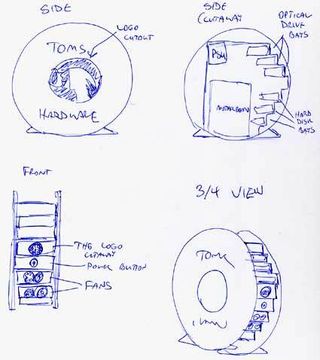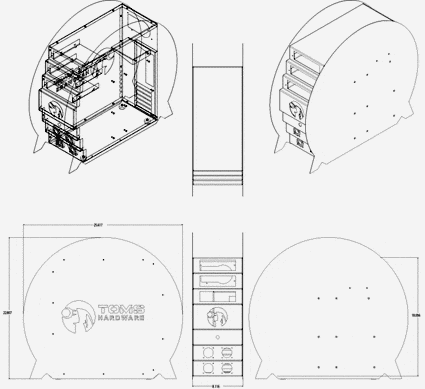Making a custom PC enclosure with Protocase
Review Of Design Process, Continued
Christa's response was a bit sobering. She seemed surprised that I'd submitted something so simple and wanted me to reconsider the design, suggesting that the folks at Protocase could perhaps design something a little more exciting for our article if I gave them some input.
The Protocase team was willing to hold my hand through the process, and fill in the blanks that I could not. All I really had to do was submit my idea to them and they'd flesh it out. This is one of the strengths of working with a company like Protocase: if you can do it yourself they're happy to simply manufacture your well thought out plans - but if all you have is a rough idea and no experience making a PC case, they will help you from start to finish.
Excited at the prospect of resurrecting my original cylindrical design, I excitedly sketched it out on a scribbled piece of paper, and faxed it to Protocase.

Attempt number 2, the scrawlings of a madman
Christa thought this idea was pretty cool, and even more importantly, doable. Armed with the new design idea, she went to work to make it happen. It turns out that I had been experiencing anxiety about this project for no real reason, as all I had to do was send them a sketch of my idea and the folks at Protocase were happy to work out the rest.
A couple of days passed, and Christa sent me images showing how the design was coming along. I was impressed at how quickly it took shape, and was given the opportunity to make comments and give input every step of the way.
After a few iterations, when we finally thought we were finished the design process, Christa sent me files that could be viewed with Solidworks' eDrawings software, a freeware 2D and 3D CAD viewer. This is what it looked like.
Stay on the Cutting Edge
Join the experts who read Tom's Hardware for the inside track on enthusiast PC tech news — and have for over 25 years. We'll send breaking news and in-depth reviews of CPUs, GPUs, AI, maker hardware and more straight to your inbox.

The second design, translated to CAD by Protocase's staff
Looking good! I gave Christa the official stamp of approval, and go-ahead for the case to begin manufacturing. The Protocase team really came through for me as far as fleshing out the design, but then the question became: how close would the final, actual hardware come to the design?
Current page: Review Of Design Process, Continued
Prev Page Review Of Design Process Next Page ResultsMost Popular

